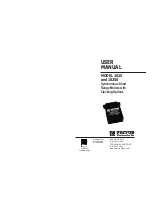
CONNECT RADIOS
13
Pin 2 – Ground/Shield – black and shield of 9-wire cable and shield of audio cable
Connect the push-to-talk ground and AFSK shield to this line. With some transceivers which do not
reference PTT and audio shielding to a common ground, it may be necessary to leave the AFSK
shield (braided wire) disconnected. NOTE: All TNC grounds are common.
Pin 3 – Push-To-Talk – brown lead
This line controls the PTT line in your transceiver, allowing the computer to switch the transceiver
from/to transmit or receive. Connect directly to the PTT line of the mic-jack connector.
Pin 4 – Key Out – orange lead
This line may be used to control CW keying on your transceiver. Separate a small length of this
lead and attach a lead with the appropriate plug for your transceiver key jack, where you would
normally connect a straight key.
Pin 5 – FSK Out – red lead
This line is for use if your transceiver provides FSK keying for RTTY operation. Separate a small
length of this lead and attach a lead with the appropriate plug for your FSK input connector on the
transceiver. It will also be necessary to provide for PTT keying via the mic jack, accessory port or
other method specified by your transceiver manual.
Pin 6 – Audio signal – 2 conductor audio cable, center conductor and 9-wire cable, purple conduc-
tor
Plug this lead to one leg of the Y-connector cable provided in the
KAM
accessory bag. Plug the Y-
connector cable into the external speaker jack of the transceiver. The remaining female connector
on the Y-connector may be used for an external speaker. Do not use a headphone output from the
transceiver. If you use an accessory or phone patch output, it may be necessary to provide a pad-
ding network to reduce amplitude of the signal being fed to the
KAM
. High level fixed outputs may
have a tendency to "swamp" the
KAM
input circuits. Fixed output signals in excess of 50 mV
should be padded.
Pin 7 – Blue lead
This pin is not connected in the
KAM
but the blue conductor of the 9-wire cable is attached to this
pin.
Pin 8 – XCD – yellow lead
This line may be used to connect the squelch line from your HF transceiver if desired. This connec-
tion will not normally be required, nor used, unless operating on a shared voice channel. (See the
CD parameter in the Commands Manual.)
Summary of Contents for KAM
Page 7: ...BACK PANELS 3 Back Panels KAM KPC 4 KPC 2 KPC 2400 KPC 1...
Page 43: ...39 KAM COMPONENT PLACEMENT DIAGRAM...
Page 44: ...40 KAM SCHEMATIC...
Page 45: ...41...
Page 47: ...43 KPC 4 COMPONENT PLACEMENT DIAGRAM...
Page 48: ...44 KPC 4 SCHEMATIC...
Page 50: ...46 KPC 2 COMPONENT PLACEMENT DIAGRAM...
Page 51: ...47 KPC 2 SCHEMATIC...
Page 53: ...49 KPC 2400 COMPONENT PLACEMENT DIAGRAM...
Page 54: ...50 KPC 2400 SCHEMATIC...
















































